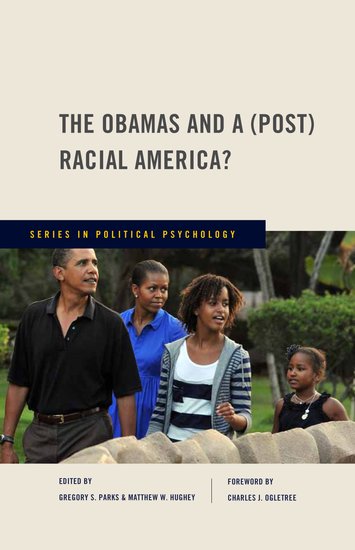The Obamas and a (Post) Racial America?
Oxford University Press
January 2011
336 pages
6-1/8 x 9-1/4
Hardback ISBN13: 9780199735204; ISBN10: 0199735204
Edited by
Gregory Parks, Assistant Professor of Law
Wake Forest University, Winston Salem, North Carolina
Matthew Hughey, Associate Professor of Sociology
University of Connecticut

The United States has taken a long and winding road to racial equality, especially as it pertains to relations between blacks and whites. On November 4, 2008, when Barack Hussein Obama was elected as the forty-fourth President of the United States and first black person to occupy the highest office in the land, many wondered whether that road had finally come to an end. Do we now live in a post-racial nation?
According to this book’s contributors, a more nuanced and contemporary analysis and measurement of racial attitudes undercuts this assumption. They contend that despite the election of the first black President and rise of his family as possibly the most recognized family in the world, race remains a salient issue-particularly in the United States. Looking beyond public behaviors and how people describe their own attitudes, the contributors draw from the latest research to show how, despite the Obama family’s rapid rise to national prominence, many Americans continue to harbor unconscious, anti-black biases. But there are whispers of change. The Obama family’s position may yet undermine, at the unconscious level, anti-black attitudes in the United States and abroad. The prominence of the Obamas on the world stage and the image they project may hasten the day when America is indeed post-racial, even at the implicit level.
Features
- Draws on a growing body of scholarly literature on implicit racial bias.
- Discusses the implications of the entire First Family’s rise to prominence, not simply the President’s.
Contents
- Contributors
- Introduction
- Chapter 1: Measuring Racial Progress in America: The Tangled Path of Race – by Matthew W. Hughey (Commentary: Constraint and Freedom in the “Age of Obama” – by Kenneth Mack)
- Chapter 2: Implicit Bias: A Better Metric for Racial Progress? – Leslie Ashburn-Nardo, Robert Livingston and Joshua Waytz (Commentary: The Erasure of the Affirmative Action Debate in the Age of Obama – by Ian Ayres)
- Chapter 3: Black Man in the White House: Ideology and Implicit Racial Bias in the Age of Obama – by Kristin Lane and John Jost (Commentary: Black Man in the White House: A Commentary – Marc H. Morial)
- Chapter 4: Obama-nation?: Implicit Beliefs about American Nationality and the Possibility of Redefining Who Counts as “Truly” American – by Nilanjana Dasgupta and Kumar Yogeeswaran (Commentary: As American as Barack Obama – by Lawrence Bobo)
- Chapter 5: Does Black and Male Still = Threat in the Age of Obama? – by Jennifer A. Richeson and Meghan G. Bean (Commentary: Threat, Fantasy, and President Obama – by Eddie Glaude, Jr.)
- Chapter 6: Michelle Obama: Redefining Images of Black Women – by Shanette C. Porter and Gregory S. Parks (Commentary: First Lady Michelle Obama: Getting Past the Stereotypes – Julianne Malveaux)
- Chapter 7: Barack, Michelle and the Complexities of a Black “Love Supreme” – Clarenda M. Phillips, Tamara L. Brown and Gregory S. Parks (Commentary: The Obamas: Beyond Troubled Love – by Jenée Desmond-Harris)
- Chapter 8: Malia and Sasha: Re-envisioning Black Youth – by Valerie Purdie-Vaughns and Rachel Sumner (Commentary: Re-envisioning Black Youth: A Commentary by Marc Lamont Hill)
- Chapter 9: Obama and Global Change in Attitudes about Group Status – by George Ciccariello-Maher and Matthew Hughey (Commentary: Commentary on Obama and Group Change in Attitudes about Group Status – Michael Dawson)
- Chapter 10: The Role of Race in American Politics: Lessons Learned from the 2008 Presidential Election – by Thierry Devos (Commentary: The State of the Post-racial Union – by Farai Chideya)
- Chapter 11: Obama’s Potential to Transform the Racial Attitudes of White Americans – by Jack Dovidio, Samuel L. Gaertner, Tamar Saguy and Eric Hehman (Commentary: Black Behavior and Moral Dissonance: Missing Mechanisms in Theorizing the Obama Effect – by Richard O. Lempert)
- Chapter 12: New Bottle, Same Old Wine: The GOP and Race in the Age of Obama – by Russell J. Webster, Donald A. Saucier and Gregory S. Parks (Commentary: New Bottle, Same Old Wine: A Response – by Melissa Harris-Lacewell)
- About the Editors, Contributors, and Commentators
- Index